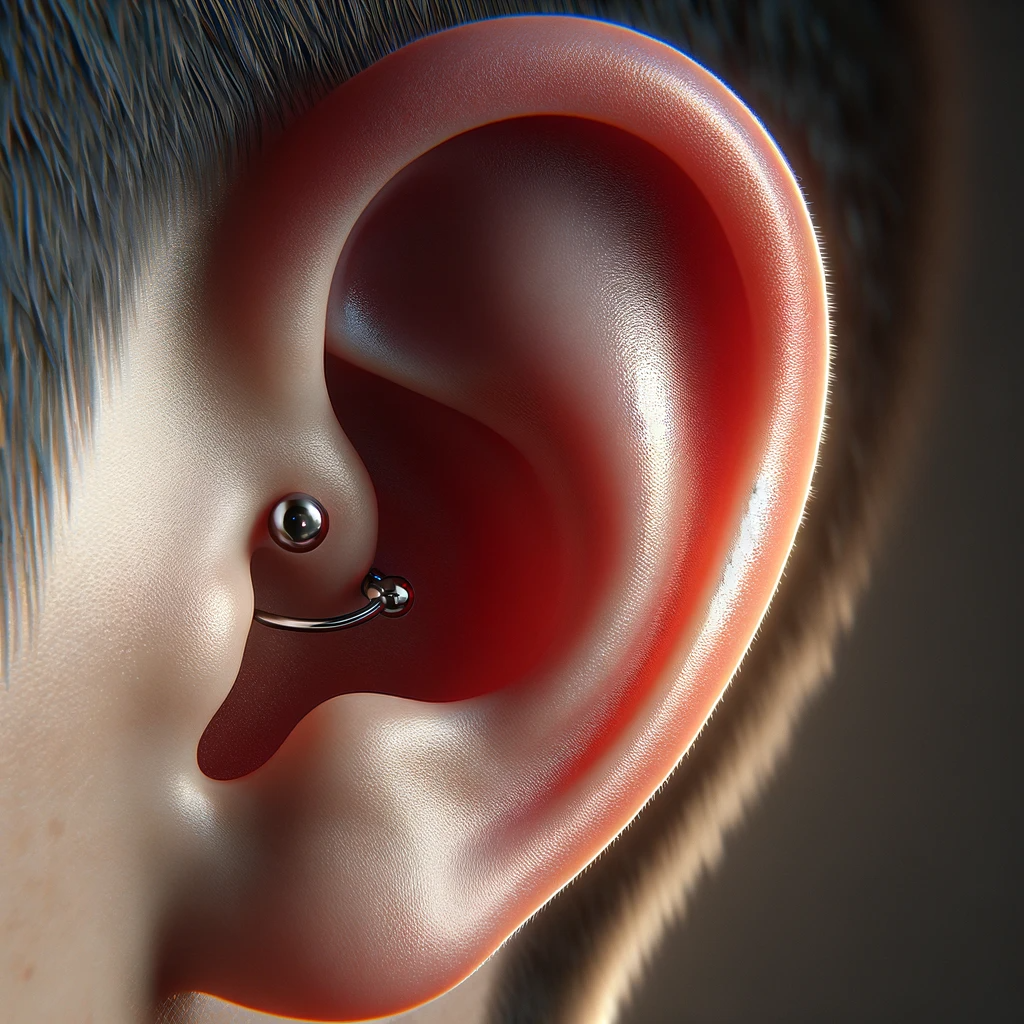Adorning Elegance: A Guide to the Art and Care of Snug Piercings
Snug piercings, a unique and striking form of body art, offer a distinctive way to express personal style and creativity. Nestled along the inner cartilage of the ear, these piercings stand out for their subtlety and elegance. Unlike more common ear piercings, snug piercings require a keen eye for detail and precision, making them a favorite among body art connoisseurs.
Noteworthy for their versatility, snug piercings can be adorned with a variety of jewelry styles, from minimalist bars to ornate rings, each adding a different character to the piercing. However, this art form is not just about aesthetics. The placement of a snug piercing demands careful consideration due to the unique anatomy of each individual's ear, highlighting the importance of personalized consultation with a skilled piercer.
Moreover, snug piercings present a specific set of aftercare challenges due to their location. They typically have a longer healing time compared to other ear piercings and require diligent care to avoid complications. This guide aims to discuss the practicalities of snug piercings, from the initial decision-making process to the aftercare and maintenance, ensuring that your piercing experience is both satisfying and safe.
So, whether you're at a tattoo and piercing shop thinking about your next piece of body art or seeking to understand the nuances of snug piercings better, this article is designed to make your experience enriching and fulfilling.
What is a Snug Piercing?
In body art, snug piercings emerge as a captivating and unique element. These piercings, known for their distinct placement, nestle along the inner cartilage of the ear, halfway down the outer rim. This specific location sets them apart from other ear piercings, which are typically found on the softer, more flexible parts of the ear. The snug ear piercing, with its firm positioning against the ear’s cartilage, presents an intriguing blend of subtle elegance and bold statement.
What truly makes snug piercings stand out is their aesthetic appeal. These piercings offer a versatile canvas for personal expression. Whether adorned with a snug piercing hoop or a delicate bar, each piece of jewelry selected adds a unique dimension to your style. The snug's placement, not overtly prominent yet always noticeable, allows for a range of jewelry styles. From the understated elegance of a simple hoop to the striking statement of a jeweled bar, the snug piercing adapts to your personal taste and style narrative.
The snug piercing's versatility extends beyond mere ornamentation. It's a form of art that resonates with the individual's personality and aesthetic preferences. In the world of ear piercings, where each location and style carries its own symbolism and flair, the snug piercing holds a special place. It's for those who appreciate the understated yet impactful, those who seek to express themselves in a way that's both personal and pronounced.
Choosing Your Snug Piercing
When you step into the world of snug piercings, selecting the right jewelry isn’t just a matter of style; it’s about finding a piece that harmonizes with your body. The snug piercing, with its distinctive placement along the ear’s inner cartilage, offers a canvas for personal expression. But remember, the right choice in snug piercing jewelry is crucial for both aesthetic appeal and comfort.
First, let’s talk materials. Opting for high-quality, hypoallergenic options is more than just a luxury—it’s a necessity. Materials like titanium, surgical stainless steel, or even certain gold alloys are ideal. They’re not only durable but also reduce the risk of allergic reactions and skin irritations. Imagine your snug piercing as a long-term commitment to your style, and choose jewelry that upholds that commitment.
Now, consider the design. Do you prefer a subtle, understated look or something that makes a bold statement? Jewelry for snug piercings varies from small, sleek barbells to decorative rings. Each type offers a different aesthetic and feel. A double snug piercing, where two pieces of jewelry are placed parallel in the snug area, can create a captivating and unique look. It’s a choice that speaks volumes about your personal style.
Personalization Tips
Personalizing your snug piercing transcends simply choosing a piece of jewelry; it’s about integrating it into your overall style and existing piercings. This is where you can truly showcase your individuality. If you already have other ear piercings, consider how your snug piercing will complement them. A well-chosen snug piercing can create a harmonious balance with your existing ear art, whether it’s a lone statement piece or part of a symphony of piercings.
For those who adore a bit of edge, mixing and matching different jewelry styles can be thrilling. Pair a minimalist barbell in your snug piercing with more ornate pieces in your lobe or helix piercings. Or, for a more cohesive look, choose jewelry that follows a certain theme or color scheme. The beauty of a piercing snug against the ear is that it offers a discrete yet impactful way of expressing your personality.
The Piercing Process
Getting a snug septum piercing is an exciting step in expressing your unique style and personality. Understanding the process helps in making this experience both enjoyable and safe.
Choosing a Reputable Piercer
Your choice of piercer is crucial. A reputable piercer doesn’t just bring skills to the table; they ensure the highest standards of safety and hygiene. Look for a professional who has a solid portfolio of snug piercings, glowing reviews, and a willingness to answer all your questions. Remember, a skilled piercer is not just a technician; they're an artist and a guide. When you hear 'piercing snug', think expertise, precision, and care.
The process of getting a snug piercing is intricate. Unlike a standard lobe piercing, snug piercings are located on the cartilage inside your ear, a spot that requires careful handling. Your piercer will first mark the spot to ensure perfect placement. Then, using a sterilized needle, they'll create the piercing with precision. It's a quick process, but one that requires steady hands and an eye for detail. If you're contemplating a conch snug piercing, remember, each piercing will be done individually, and spacing is key for a balanced, symmetrical look.
Preparation Tips
Preparing for your snug piercing appointment is as important as the procedure itself.
Health Considerations: Make sure you're well-rested and hydrated before your appointment. Avoid alcohol or caffeine as they can increase bleeding. If you have any medical conditions, especially those affecting the skin or blood, discuss them with your piercer beforehand.
Aftercare Purchases: Invest in a quality saline solution for aftercare. Also, consider purchasing a mild, fragrance-free soap to clean the area around the piercing.
Mental Preparation: It's normal to feel a mix of excitement and nerves. Stay calm and remember why you chose to embark on this journey – it’s a form of self-expression and an art that resonates with your individuality.
Post-Piercing Expectations
After the piercing, your piercer will provide you with detailed aftercare instructions. Follow these diligently to ensure a smooth healing process. It's normal to experience some swelling and snug piercing pain, but if you notice any signs of infection, consult your piercer or a healthcare professional immediately
Aftercare and Maintenance of Snug Piercings
After you've adorned your ear with a snug piercing, the first few weeks are crucial for healthy healing. It's essential to follow a meticulous aftercare routine to safeguard your new piercing.
Cleaning Your Piercing
Gently clean the area around your snug piercing twice a day using a saline solution. Avoid alcohol-based cleaners as they can be too harsh.
Dab the solution with a clean cotton swab around both ends of the jewelry, being careful not to rotate or move the jewelry excessively.
Recognizing Healthy Healing Signs
A normal healing snug piercing may show some redness and emit a mild, clear discharge.
It's typical for the area to feel tender for the first few days. However, this should gradually subside.
What to Avoid
Keep the pierced area dry and clean. Avoid submerging it in bodies of water like pools or hot tubs.
Resist the urge to touch or twist the jewelry, as this can introduce bacteria or cause irritation.
Long-Term Care: Maintaining Your Snug Piercing
Once your piercing has healed, ongoing care is key to maintaining its beauty and health.
Routine Cleaning
Continue to clean your piercing regularly, even after it has healed, to prevent build-up and infection.
Use a mild soap and water during your daily shower to gently cleanse the area.
Jewelry for Snug Piercing
Choose jewelry made from high-quality materials like surgical steel, titanium, or gold to avoid allergic reactions or infections.
When you're ready to change your jewelry, opt for pieces that complement your style and don't put undue pressure on the piercing.
Dealing with Potential Issues
Even with the best care, snug piercings can sometimes run into issues.
Addressing Infections:
Signs of infection include excessive redness, swelling, pain, or yellowish discharge.
If you suspect an infection, consult a professional. Do not remove the jewelry yourself as it can cause the hole to close and trap the infection.
Managing Irritation:
Sometimes, snug piercings can get irritated due to friction from clothing, hair, or sleep positions.
Identify the cause of irritation and try to minimize it. For example, if sleeping on the piercing causes issues, adjust your sleeping position.
Considering a Faux Snug Piercing
If you love the look but are concerned about healing and maintenance, consider a faux snug piercing. This gives the appearance of a snug piercing but typically involves two separate piercings that are easier to heal and maintain.
-
A: A snug piercing is generally considered to be moderately painful. The level of pain experienced can vary from person to person, as it depends on individual pain tolerance. The snug area, located in the cartilage of the ear, is a bit more sensitive than the lobe, so you might feel a sharp pinch or pressure during the piercing process. The discomfort is usually brief, but the area can be tender for some time during healing.
-
A: No, a snug piercing is not the same as a conch piercing. A snug piercing is located in the middle of the ear's outer rim, specifically in the inner cartilage area close to the ear canal. In contrast, a conch piercing is situated in the center part of the ear cartilage, and can be either in the inner (inner conch) or outer (outer conch) part of the ear. The primary difference lies in their locations on the ear and the types of jewelry typically used for each.
-
A: Snug piercings are not extremely rare, but they are less common than other ear piercings like the lobe or helix piercings. This is partly due to the snug piercing's specific placement along the inner cartilage of the ear, which can be more challenging to pierce and heal properly. Its relative rarity can also be attributed to the fact that not everyone's ear anatomy is suited for this particular type of piercing.
READ MORE…
Get modern body piercings at certified tattoo
Exploring the unique beauty and care of bridge piercings
What you need to know about the most popular types of piercings
The history of piercings





